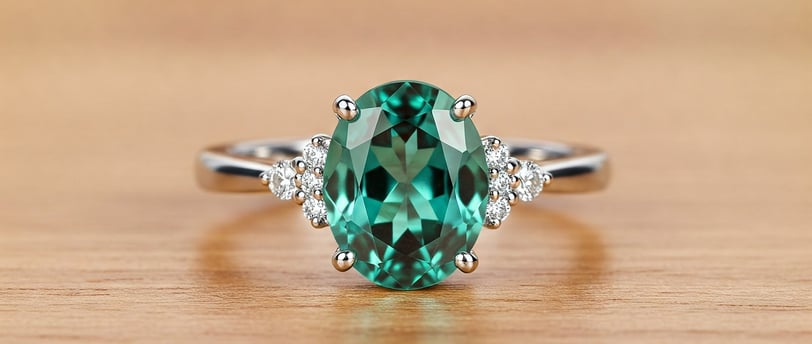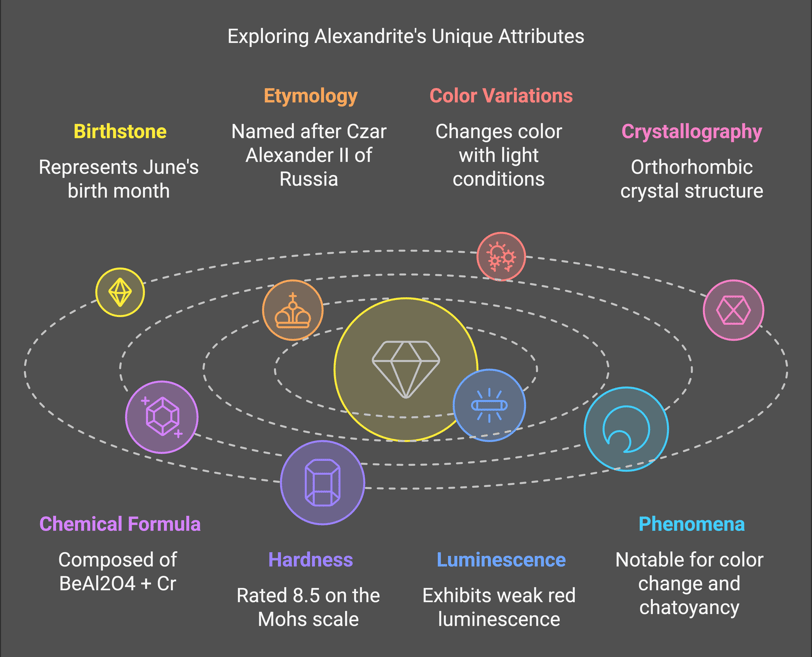Alexandrite
Explore the world of alexandrite, the rare colour-changing gem, known as "emerald by day, ruby by night".
1/30/20253 min read


History
Alexandrite, often called "emerald by day, ruby by night", is known for its remarkable colour change. This gem was first discovered in the 1830s in Russia's Ural Mountains and was named after Czar Alexander II. The gem's colours also happened to mirror the military colours of Imperial Russia, which helped it quickly gain popularity. Alexandrite is a rare variety of the mineral chrysoberyl and is considered a modern June birthstone. It is also the gem for the 55th wedding anniversary. The connection to the Czars likely helped the gem gain prestige. Alexandrite is so rare and expensive that few people have seen a natural one.
Mineral Origins
Alexandrite is a variety of the mineral chrysoberyl. Its formation requires the rare elements beryllium (Be) and chromium (Cr) which are not often found together. The original source of alexandrite in the Ural Mountains was nearly depleted after a few decades of mining. Since the 1980s, new sources have been discovered in places like Sri Lanka, East Africa, and Brazil, but fine material remains exceptionally rare and valuable. Other sources include Madagascar, Myanmar, and Zimbabwe. Brazilian alexandrites can rival the colours of Russian material but have decreased in production. Indian material tends to have excellent green-blue daylight hues with weak colour change, although strong colour-changing specimens do occur. Sri Lankan alexandrite often appears deep olive-green in sunlight, while Russian stones appear bluish green. Zimbabwean gems show a fine, emerald-green colour in sunlight but are usually tiny.
The 4 Cs
Colour
Fine alexandrite is green to bluish-green in daylight and red to purplish-red in incandescent light. The most valuable gems exhibit a 100% colour shift from pure green to pure red. The closer the colours are to pure green and red, the higher the value. The intensity of the colour change is also a crucial factor. A good quality alexandrite has few inclusions. Stones that are too light lack colour intensity, while those too dark lack brightness and may appear almost black. The colour change is caused by the way alexandrite absorbs light, with a specific absorption band at 580nm that allows it to shift from red to green under different light sources. Darker tones often correspond to a more intense colour change, and tones of 75-85% are ideal.
Clarity
Alexandrite tends to have few inclusions and a dramatic rise in value is seen for clean material with good colour change and strong colours. Most naturally occurring alexandrite isn’t clean, and most is best suited for cabbing. However, an alexandrite’s colour change has a greater impact on its value than its clarity. Rutile inclusions may enhance the colour change, resulting in a higher overall price. Needle-like inclusions can create a cat's-eye effect.
Carat
Most cut alexandrites weigh less than one carat. Larger, higher-quality gems increase in price dramatically. Stones over five carats are very rare, especially with good colour change. Alexandrites above 0.25 carats are rare, but specimens of 10 carats and larger are available. Generally, larger stones exhibit weaker colour changes and lesser clarity.
Cut
Most alexandrite is not cut very well because of its rarity and tendency to have inclusions. Stones cut for weight retention are often asymmetrical, but they still hold value if the gem is high quality. Oval and cushion cuts are the most common for alexandrite. When cutting alexandrite, gem cutters must orient the gem to show the strongest colour change through the crown, positioning it so both the purplish red and green pleochroic colours are face-up.
Be Aware Of
Enhancements
There are a number of processes used to alter the colour, apparent clarity, or improve the durability of gems.
Simulants
Any gem can be imitated—sometimes by manmade materials or by natural materials chosen by man to impersonate a particular gem. Some unscrupulous vendors will sell any stone that changes colour as alexandrite.
Synthetics
Some gemstones have synthetic counterparts that have essentially the same chemical, physical, and optical properties but are grown in a laboratory. Synthetic alexandrites have the same chemical and physical properties as natural ones, although they cost less. Gemologists can sometimes identify synthetic alexandrites by inclusions caused by various growth procedures. Synthetic alexandrites are created through melt, hydrothermal, or flux methods. Melt techniques, like the Czochralski method, can create curved striae. Hydrothermal growth can create bubbles and liquid inclusions. Flux methods can leave inclusions of platinum or other seed materials. A considerable market exists for lookalikes or simulants, which can range from synthetic corundum with alexandrite-like colour change to actual, natural colour-change chrysoberyl stones.
Final Thoughts
Buying Tips
When purchasing alexandrite, pay attention to the lighting and ask about the colour temperature of the light bulbs used. Bulbs with 3000-3300K are incandescent light, and 5000-6500K can simulate daylight. Be aware that simulated daylight can be more flattering than natural sunlight, and, if possible, view the alexandrite outdoors. Always request an identification report from a gemological laboratory to ensure the gem is an alexandrite. If you find an alexandrite at a relatively bargain price, it's likely not natural and possibly not an alexandrite.
Jewelry Care
With a hardness of 8.5, alexandrite is a durable stone suitable for any jewelry setting. However, care should be taken when faceting the stone, as it is sensitive to knocks and extreme heat. There are no special care requirements, and the gem can be cleaned mechanically or with warm, soapy water and a brush.


Gemius Stones
Expertise
© 2025. All rights reserved.
